Vincent Price Carries out Elaborate Revenge in Darkly Humorous Horror Double Feature
DIRECTED BY ROBERT FUEST/1971, 1972
BLU-RAY STREET DATE: APRIL 12, 2022/KL STUDIO CLASSICS
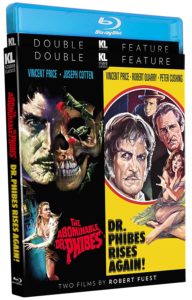
Were there ever more charming sadistic murderers in all of movie history than those portrayed by Vincent Price? In the latter end of his on-screen career, he ramped up both his charm and his bloodletting for American International Pictures efforts such as the oddity Scream and Scream Again (1970) and the savagely delicious Theater of Blood (1973). While Michael Reeves’ uncompromisingly intense Witchfinder General (1968) got this particular ball rolling, Price, with A.I.P., went on to deliver a myriad of deadly doings in a now-treasured assortment of off-kilter cinema, as creepy as it could be catty. The keystones in this particularly lively mausoleum of madness, however, must be filmmaker Robert Fuest’s two-fer of Dr. Phibes films, The Abominable Dr. Phibes (1971) and Dr. Phibes Rises Again (1972).
Might the erudite undead and technologically modified Phibes- once a great concert organist and theologian but now the world’s most innovative killer circa 1925- be Price’s singularly strangest character? Many certainly consider it quintessential in his career, as it propelled his 1970s comeback into high gear. With an ashen mop-top on his head and a metal port protruding three inches from the side of his neck, Price’s stringently cobbled together and back-from-the-dead eccentric weilds a look all his own. In a gleefully sinister couple of films such as these, there’s a macabre rightness about all of it.
Though Phibes is physically unable to speak, his voice is heard via makeshift amplification of the character’s own devising. With an oversized phonograph horn in tow and a thick audio cable plugged into his neck’s manmade port, the twisted doctor’s reconstructed voice is its own eerie abnormality. As for Price, he gets away with both a silent performance and a classically verbose one composed entirely of externally-recorded dialogue that he didn’t have to memorize. Which is to say, Phibes’ voice will be heard- and once anyone onscreen hears it, they’ll absolutely wish they hadn’t!
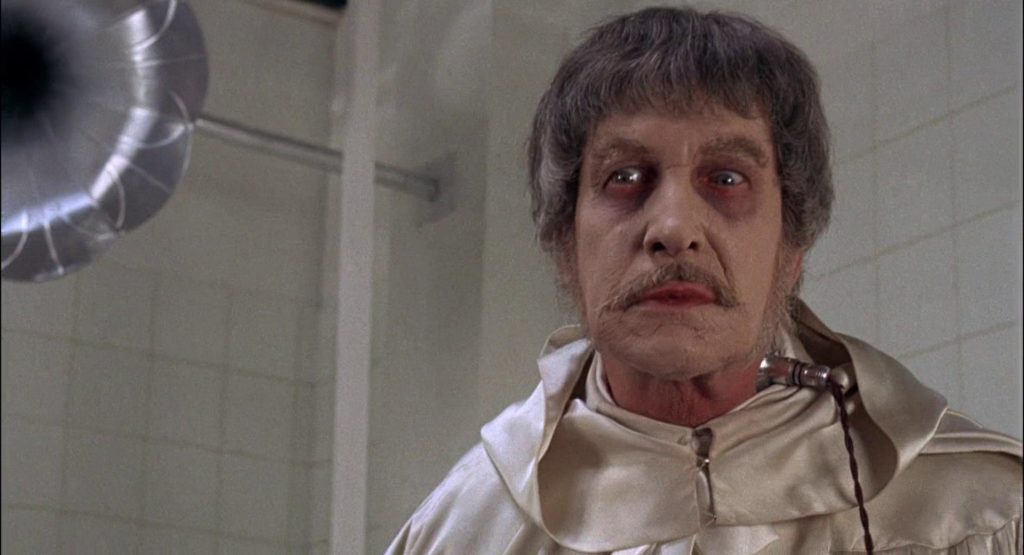
Anyone, that is, except for Dr. Phibes’ uncanny and mute personal assistant, Vulnavia (initially played by Virginia North, then Valli Kemp). Though it’s never explained, the strange young ornately-dressed woman is likely a more elaborate clockwork creation not unlike Dr. Phibes’ Clockwork Wizards, the music-making automatons that play along with their evil master’s own ominous organ grinding. In the first film, the macabre classic The Abominable Dr. Phibes, all of this occurs out in a cavernous cave, his pipe organ rising up or down on a hydraulic lift as he plays. The organ itself is adorned with lit, curved pink plexiglass fins, casting an image that likely lodged into dreams of young Nicholas Winding Refn.
“Nine killed her, nine shall die, nine eternies in doom!”
Perhaps a more succinct explanation is in order. Circa 1921, Phibes and his beloved wife (an uncredited Caroline Munro) were banged up horribly in a terrible auto accident while traveling through Switzerland. The doctors, despite their skills and best efforts, were unable to save her. Phibes, barely alive himself, blamed these medical professionals. He spent the next four years “resurrecting” himself and devising an array of elaborate infernal murder machines based upon the book of Exodus’ ten plagues of Eygpt. As The Abominable Dr. Phibes begins, he’s already gone about killing one of the doctors.
Phibes’ demented melding of old-timey engineering and showmanship is established as we witness his target at a costume party slowly get his head crushed by a rigged, constricting frog mask. Particularly freaky is another inflicted death by large bats that descend upon a man in his bed. There are several more clever kills, even as a final “plague of darkness” is threatened as the inescapable finale.
The observant Inspector Trout (played by Peter Jeffrey in both films) deduces that the serially murdered victims all have a connection to one Dr. Vesalius (Joseph Cotten). Cotten, a working professional through and through, pours his all into this unjustly marked surgeon. Also in the mix are comedy actor Terry-Thomas, as well as Sean Bury, Edward Burnham, Alex Scott, and Peter Gilmore. The film is correctly considered a classic unto itself.
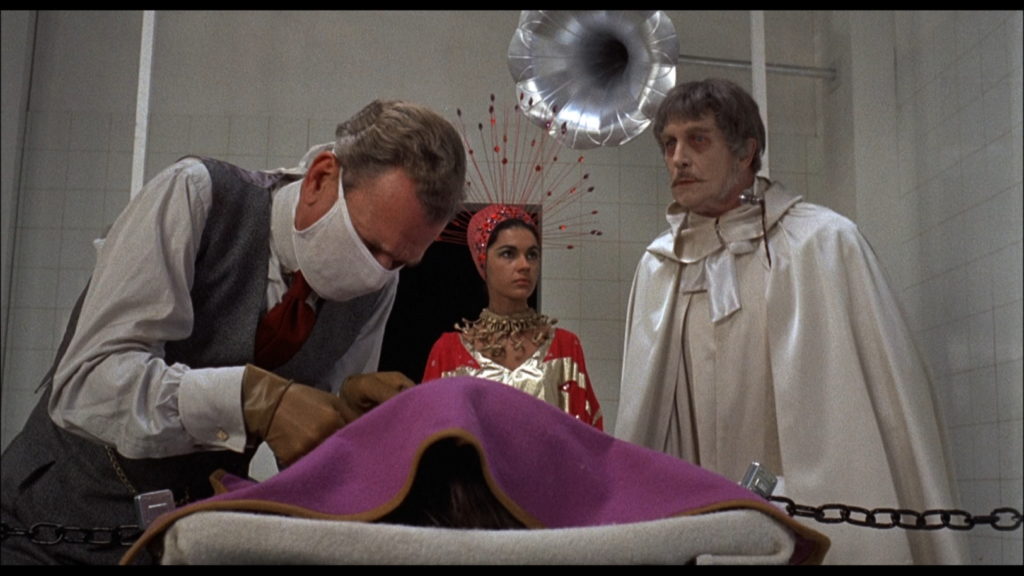
“Those devils! To take from me the two treasures of my life! I shall get them back; he who tries to stop me will die!”
The 1972 sequel, which brings back both Phibes, Vulnavia (now played by a slightly less beguiling but every bit impeccable Valli Kemp), and Fuest, was decreed to be a more reigned-in affair. While Fuest (best known then for directing fan-favorite episodes of TV’s The Avengers) went ahead and made a film in the idiosyncratic shadow of the first, the studio nevertheless saw fit to trim and widdle out as much of the humor and peculiarities as it could. What we’re left with is a film that, upon initial viewing, still manages to stand quite nicely alongside of its original but does demonstrate a weaker overall focus. Price is no less compelling, even as several of his character’s sadistic edges are somewhat sanded down.
Rises Again indeed begins with the doctor rising again alongside the body of his beloved, preserved wife. In the three years that we’re told have passed since the last film, his lavish estate has been demolished. This propels him on a new quest, to the fabled youth-granting River of Life, which is well hidden in the Pharoh’s Tomb in Egypt. The problem is that the ancient scrolls he’d collected that detail the river’s location have been stolen from him. The rest of the film is Phibes elaborately murdering everyone involved in the theft as he works to recover the scrolls section by section. The rudimentary plot works well enough, even as it does inevitably cast the ruthless doctor in something of a more sympathetic light.
This is aspect is furthered along by the new co-star Robert Quarry’s (A.I.P.’s concurrently popular vampire character Count Yorga) callous portrayal of nobleman Darrus Biederbeck. Biederbeck, we learn, is centuries old and holding as an apparent forty-something only by regular ingestion of a youth-granting elixir. But, his attempts to not age are becoming less and less effective. Access to the River of Life would make his existence much better. Hence, we have something of a bloody race to the mystical river.
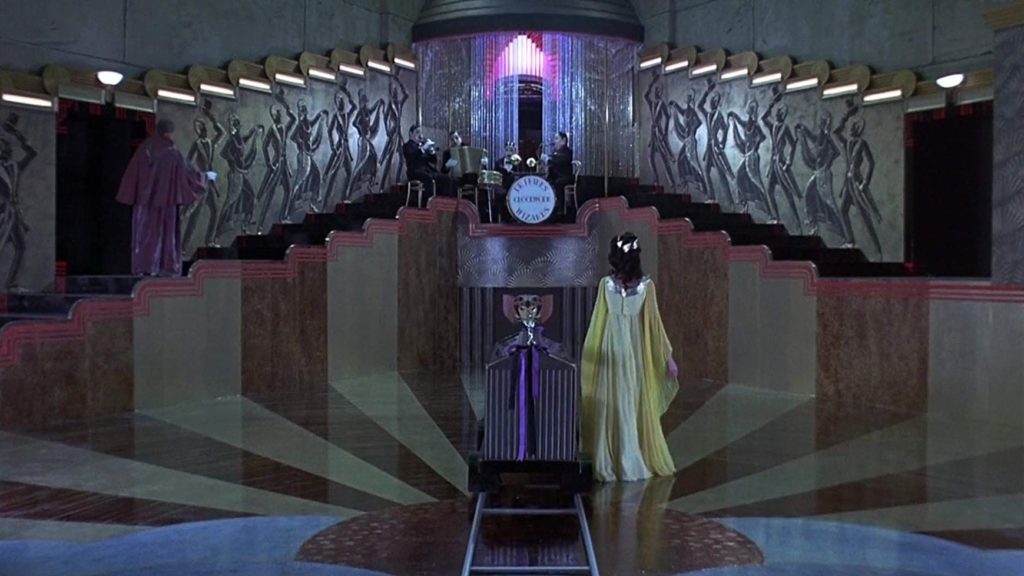
Along the way, Phibes kills Biederbeck’s people with ingeniously rigged household items as well as ridiculous contraptions such as a large cog-driven scorpion-shaped trap that releases real death-dealing scorpions. The film boasts a typical A.I.P. raft-load of costars, several of whom have little-to-nothing to do but show up briefly so their name can go on the poster. Among the cast are Hugh Griffith as an inspector, Peter Jeffrey and John Cater as a collaborating detective and superintendent, Peter Cushing as a ship’s captain, and Terry-Thomas as someone named “Lombardo”, and Fiona Lewis as Quarry’s love interest.
KL Studio Classics has wrangled both The Abominable Dr. Phibes and Dr. Phibes Rises Again together from Shout Factory, which had previously released them on Blu-ray in two seperate Vincent Price box sets that have gone in and out of print. With the exception of the opening titles (which are opticals over live action that are incapable of looking pristine), both films look and sound quite impressive. That said, there has been some dust-up over the quality of some of the audio in Abominable. This being my own first exposure to either film, I cannot confirm nor deny this flaw. What I can say is that nothing seemed wrong to me. Phibes freaks are encouraged to set the record straight, as I’m sure they will.
Both commentary tracks from Shout Factory’s release of The Abominable Dr. Phibes are included on that film’s disc. For the previously commentary-free sequel, however, Kino Lorber comes to the rescue with two brand new tracks. The first film’s moderated track with director Robert Fuest must be even older than the first Shout Factory Vincent Price set, as the filmmaker’s 2012 death preceded its release. It’s a very low-key track of two very British older gentlemen chatting about the film at hand. Fuest shares a lot of his recollections about making the film and working with Price (for example, to paraphrase: “Vincent had no sense of rhythm, which made all the formal dancing scenes a challenge”). It’s a valuable track, but be prepared to lean in and pay close attention as to not drift off amid their pleasant conversing.
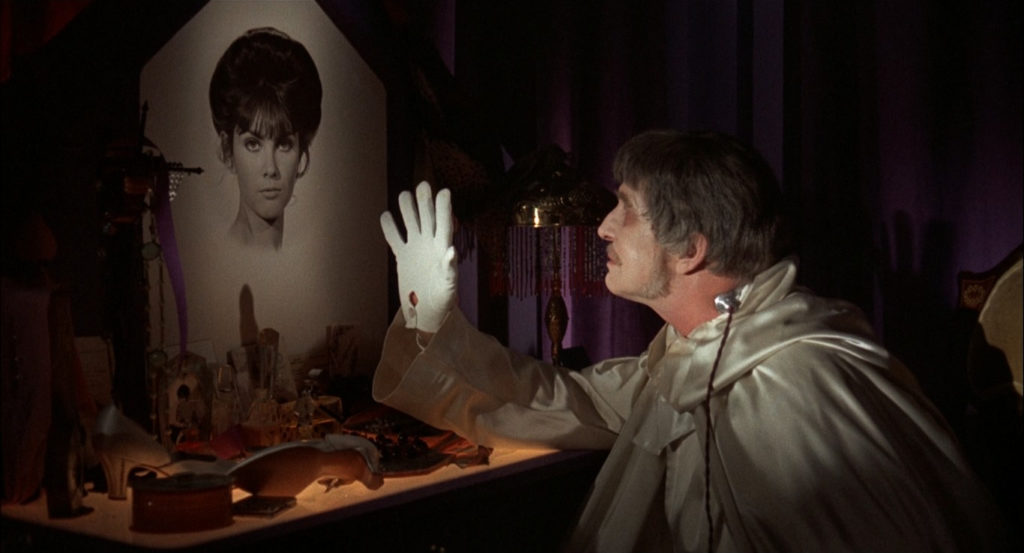
The second commentary on Abominable is by Justin Humphreys, who maintains quite high enthusiasm about the film from start to finish. Humphreys’ glowing (and entirely justified) take should be no surprise, considering that he’s the author of a book called The Dr. Phibes Companion. He gives plenty of great facts amid his self-aware appreciation, altogether indicative that Kino got the ideal commentator. Honestly, for the casual viewer, it’s a far easier listen than the director’s track.
Justin Humphreys returns for Rises Again, this time looser but no less engaging. His approach is in keeping with the general vibe of fun he describes that the cast and crew maintained while making the movie. Humphrey’s reiterates how both films, in their spark, vibrancy, and delightfully unexplained quirks, were far from indicative of the typical output of A.I.P. at the time. He credits the abundance of lively flourish to the art school backgrounds of Fuest and his art department, itself led by more art school alum.
The second commentary on Rises Again and the final commentary of this set, by none other than Tim Lucas, is the best of them all. Lucas has a gift for delivering the “hard information” (personal histories, filmographies, et cetra) intermingled with exceptionally researched anecdotes and asides. Lucas, per his own methodology, is much less off-the-cuff and outwardly energetic than Humphrey, which sets the tracks effectively apart from one another.
The visual and audio presentation of both films, while likely the same as their previous Shout Factory Blu-ray releases, are awfully good. A big part of the appeal of this Kino Lorber release is the pairing of the films in one package (each on its own disc). Besides the commentary tracks, original trailers for both films are included, as well as radio spots for Rises Again. The case comes entombed in a handsome slipcover.
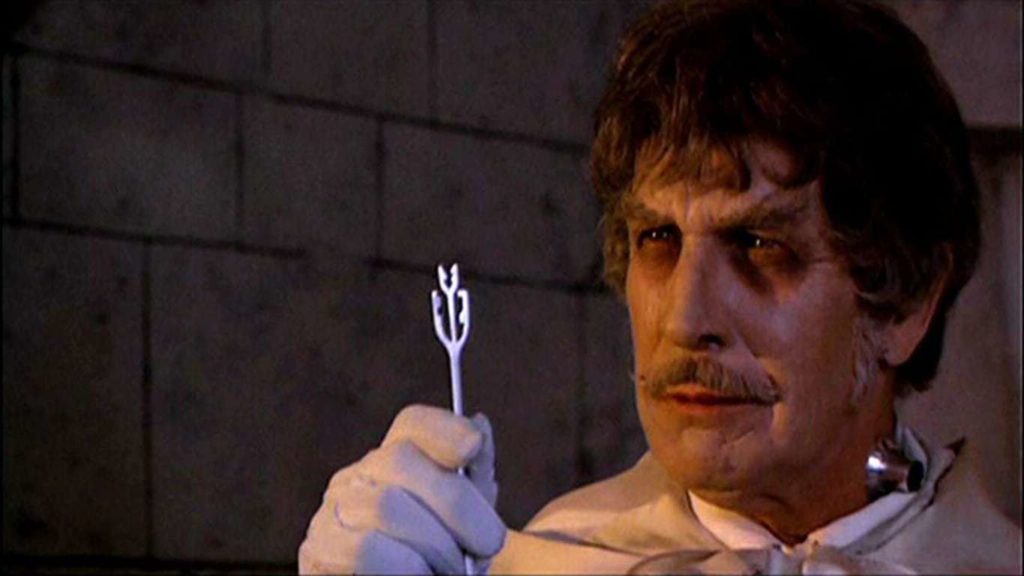
It’s a shame that Fuest and Price didn’t get to make their planned third Phibes film to complete what is said to have been an intended trilogy. As it now rests, we have two quite accomplished and quite memorable lighter horror pictures (currently rated PG-13 and PG, respectively) of a British bent that smartly value eccentricity and artistic style over cheap thrills and boilerplate plots. Fuest isn’t afraid to spill a bit of blood to get us over the anachronistic rainbow to the land of immortality with the gruesomely romantic and ever musical Dr. Phibes. Vincent Price, however, absolutely succeeded in fully resurrecting his career as a beloved horror icon for a new generation.

